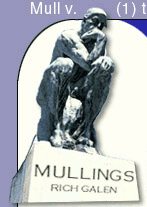


|
|
|
Rich Galen Monday August 01, 2005
In 1998, after researchers first reported the isolation of human embryonic
stem cells, President Bill Clinton requested a review of the issues
surrounding stem cell research by the National Bioethics Advisory Commission
(NBAC), a presidentially appointed committee established to advise the
federal government on bioethics issues. In September 1999, NBAC released its
report, entitled Ethical Issues in Human Stem Cell Research. The report
concluded that the federal government should fund research on, and the
derivation of, human embryonic stem cells, provided that only embryos
leftover from fertility treatments were used. It proposed that Congress
carve out an exception to its embryo research ban for the derivation of
embryonic stem cells.
Now, from a policy perspective: Congress spoke to this issue several years
ago when Congressman Roger Wicker (R-MS) and then-Congressman Jay Dickey
(R-AR) authored language that said that no NIH funds can be used for any
research involving the destruction of a human embryo. President Bill Clinton
signed that bill and then, shortly after that, came up with a way to get
around the so-called Dickey/Wicker language simply by allowing outside
researchers to destroy embryos and then move the stem cells over to NIH.
On August 23, 2000, the National Institutes of Health (NIH) published
Guidelines for Research Using Human Pluripotent Stem Cells for the public
funding of embryonic stem cell research in the United States. The guidelines
indicated that NIH would fund research using human pluripotent stem cells
from early human embryos only if investigators use cells derived from frozen
embryos that were created for purposes of infertility treatment and were in
excess of clinical need. The guidelines also identified areas of research
that were ineligible for funding and stated that no NIH funds would be used
to derive pluripotent stem cells from human embryos. Finally, the guidelines
outlined in detail the methods and procedures by which NIH will fund this
area of research, including the establishment of a Human Pluripotent Stem
Cell Review Group (HPSCRG), that would review fund.
Bush II did face the issue head-on.
The zygote undergoes cleavage, increasing the number of cells within the zona pellucida. When there are about 4-16 cells this is called the morula. When the number of cells reaches 40-150 cells, a central, fluid-filled cavity (blastocoel) forms. The zona pellucida is still present but is degenerating. This stage in the developing embryo is the blastocyst, and lasts approximately until the implantation in the uterus. The outer cells develop into the placenta.
Catchy Caption of the Day
But it struck me as one of those cone-shaped collars you put on your cat so it can't get at the stitches on ITS tail.
(US Navy/Petty Officer 3rd Class Jonathan Chandler)
Copyright ©2005 Richard A. Galen | Site design by Campaign Solutions. |




